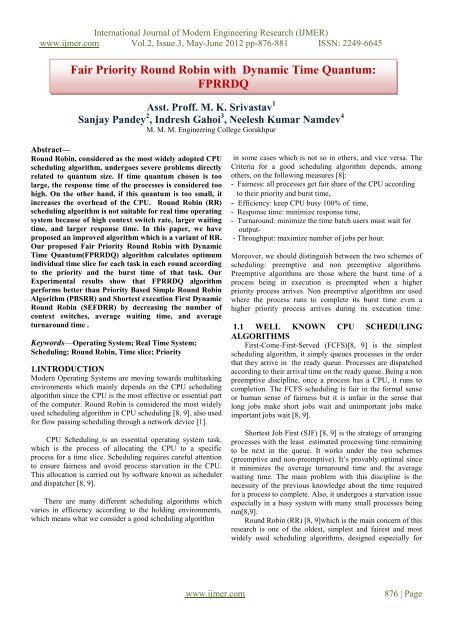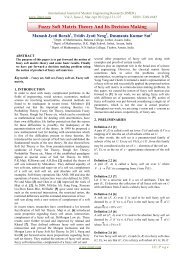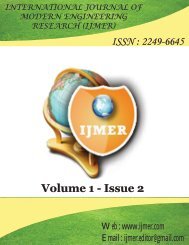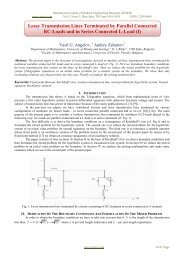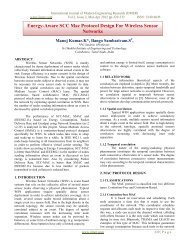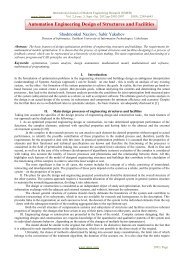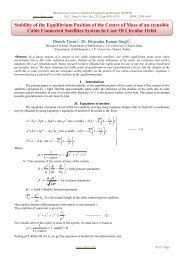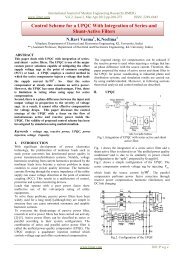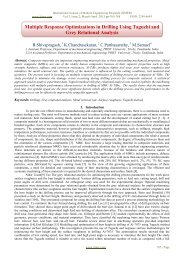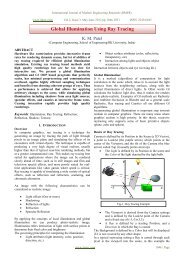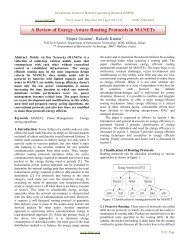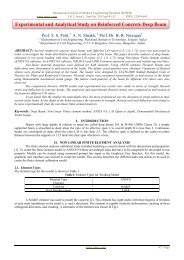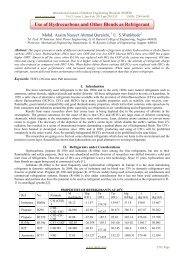IEEE Paper Template in A4 (V1) - ijmer
IEEE Paper Template in A4 (V1) - ijmer
IEEE Paper Template in A4 (V1) - ijmer
Create successful ePaper yourself
Turn your PDF publications into a flip-book with our unique Google optimized e-Paper software.
International Journal of Modern Eng<strong>in</strong>eer<strong>in</strong>g Research (IJMER)<br />
www.<strong>ijmer</strong>.com Vol.2, Issue.3, May-June 2012 pp-876-881 ISSN: 2249-6645<br />
Fair Priority Round Rob<strong>in</strong> with Dynamic Time Quantum:<br />
FPRRDQ<br />
Asst. Proff. M. K. Srivastav 1<br />
Sanjay Pandey 2 , Indresh Gahoi 3 , Neelesh Kumar Namdev 4<br />
M. M. M. Eng<strong>in</strong>eer<strong>in</strong>g College Gorakhpur<br />
Abstract—<br />
Round Rob<strong>in</strong>, considered as the most widely adopted CPU<br />
schedul<strong>in</strong>g algorithm, undergoes severe problems directly<br />
related to quantum size. If time quantum chosen is too<br />
large, the response time of the processes is considered too<br />
high. On the other hand, if this quantum is too small, it<br />
<strong>in</strong>creases the overhead of the CPU. Round Rob<strong>in</strong> (RR)<br />
schedul<strong>in</strong>g algorithm is not suitable for real time operat<strong>in</strong>g<br />
system because of high context switch rate, larger wait<strong>in</strong>g<br />
time, and larger response time. In this paper, we have<br />
proposed an improved algorithm which is a variant of RR.<br />
Our proposed Fair Priority Round Rob<strong>in</strong> with Dynamic<br />
Time Quantum(FPRRDQ) algorithm calculates optimum<br />
<strong>in</strong>dividual time slice for each task <strong>in</strong> each round accord<strong>in</strong>g<br />
to the priority and the burst time of that task. Our<br />
Experimental results show that FPRRDQ algorithm<br />
performs better than Priority Based Simple Round Rob<strong>in</strong><br />
Algorithm (PBSRR) and Shortest execution First Dynamic<br />
Round Rob<strong>in</strong> (SEFDRR) by decreas<strong>in</strong>g the number of<br />
context switches, average wait<strong>in</strong>g time, and average<br />
turnaround time .<br />
Keywords—Operat<strong>in</strong>g System; Real Time System;<br />
Schedul<strong>in</strong>g; Round Rob<strong>in</strong>, Time slice; Priority<br />
1.INTRODUCTION<br />
Modern Operat<strong>in</strong>g Systems are mov<strong>in</strong>g towards multitask<strong>in</strong>g<br />
environments which ma<strong>in</strong>ly depends on the CPU schedul<strong>in</strong>g<br />
algorithm s<strong>in</strong>ce the CPU is the most effective or essential part<br />
of the computer. Round Rob<strong>in</strong> is considered the most widely<br />
used schedul<strong>in</strong>g algorithm <strong>in</strong> CPU schedul<strong>in</strong>g [8, 9], also used<br />
for flow pass<strong>in</strong>g schedul<strong>in</strong>g through a network device [1].<br />
CPU Schedul<strong>in</strong>g is an essential operat<strong>in</strong>g system task,<br />
which is the process of allocat<strong>in</strong>g the CPU to a specific<br />
process for a time slice. Schedul<strong>in</strong>g requires careful attention<br />
to ensure fairness and avoid process starvation <strong>in</strong> the CPU.<br />
This allocation is carried out by software known as scheduler<br />
and dispatcher [8, 9].<br />
There are many different schedul<strong>in</strong>g algorithms which<br />
varies <strong>in</strong> efficiency accord<strong>in</strong>g to the hold<strong>in</strong>g environments,<br />
which means what we consider a good schedul<strong>in</strong>g algorithm<br />
<strong>in</strong> some cases which is not so <strong>in</strong> others, and vice versa. The<br />
Criteria for a good schedul<strong>in</strong>g algorithm depends, among<br />
others, on the follow<strong>in</strong>g measures [8]:<br />
- Fairness: all processes get fair share of the CPU accord<strong>in</strong>g<br />
to their priority and burst time,<br />
- Efficiency: keep CPU busy 100% of time,<br />
- Response time: m<strong>in</strong>imize response time,<br />
- Turnaround: m<strong>in</strong>imize the time batch users must wait for<br />
output-<br />
- Throughput: maximize number of jobs per hour.<br />
Moreover, we should dist<strong>in</strong>guish between the two schemes of<br />
schedul<strong>in</strong>g: preemptive and non preemptive algorithms.<br />
Preemptive algorithms are those where the burst time of a<br />
process be<strong>in</strong>g <strong>in</strong> execution is preempted when a higher<br />
priority process arrives. Non preemptive algorithms are used<br />
where the process runs to complete its burst time even a<br />
higher priority process arrives dur<strong>in</strong>g its execution time.<br />
1.1 WELL KNOWN CPU SCHEDULING<br />
ALGORITHMS<br />
First-Come-First-Served (FCFS)[8, 9] is the simplest<br />
schedul<strong>in</strong>g algorithm, it simply queues processes <strong>in</strong> the order<br />
that they arrive <strong>in</strong> the ready queue. Processes are dispatched<br />
accord<strong>in</strong>g to their arrival time on the ready queue. Be<strong>in</strong>g a non<br />
preemptive discipl<strong>in</strong>e, once a process has a CPU, it runs to<br />
completion. The FCFS schedul<strong>in</strong>g is fair <strong>in</strong> the formal sense<br />
or human sense of fairness but it is unfair <strong>in</strong> the sense that<br />
long jobs make short jobs wait and unimportant jobs make<br />
important jobs wait [8, 9].<br />
Shortest Job First (SJF) [8, 9] is the strategy of arrang<strong>in</strong>g<br />
processes with the least estimated process<strong>in</strong>g time rema<strong>in</strong><strong>in</strong>g<br />
to be next <strong>in</strong> the queue. It works under the two schemes<br />
(preemptive and non-preemptive). It’s provably optimal s<strong>in</strong>ce<br />
it m<strong>in</strong>imizes the average turnaround time and the average<br />
wait<strong>in</strong>g time. The ma<strong>in</strong> problem with this discipl<strong>in</strong>e is the<br />
necessity of the previous knowledge about the time required<br />
for a process to complete. Also, it undergoes a starvation issue<br />
especially <strong>in</strong> a busy system with many small processes be<strong>in</strong>g<br />
run[8,9].<br />
Round Rob<strong>in</strong> (RR) [8, 9]which is the ma<strong>in</strong> concern of this<br />
research is one of the oldest, simplest and fairest and most<br />
widely used schedul<strong>in</strong>g algorithms, designed especially for<br />
www.<strong>ijmer</strong>.com<br />
876 | Page
International Journal of Modern Eng<strong>in</strong>eer<strong>in</strong>g Research (IJMER)<br />
www.<strong>ijmer</strong>.com Vol.2, Issue.3, May-June 2012 pp-876-881 ISSN: 2249-6645<br />
time-shar<strong>in</strong>g systems. It’s designed to give a better responsive<br />
but the worst turnaround and wait<strong>in</strong>g time due to the fixed<br />
time quantum concept. The scheduler assigns a fixed time unit<br />
(quantum) per process usually 10-100 milliseconds, and<br />
cycles through them. RR is similar to FCFS except that<br />
preemption is added to switch between processes [2, 3, and 8].<br />
1.2RELATED WORK<br />
Matarneh [2] founded that an optimal time quantum<br />
could be calculated by the median of burst times for the set of<br />
processes <strong>in</strong> ready queue, unless if this median is less than<br />
25ms. In such case, the quantum value must be modified to<br />
25ms to avoid the overhead of context switch time [2]. Other<br />
works [7], have also used the median approach, and have<br />
obta<strong>in</strong>ed good results.<br />
Helmy et al. [3] propose a new weight<strong>in</strong>g technique<br />
for Round-Rob<strong>in</strong> CPU schedul<strong>in</strong>g algorithm, as an attempt to<br />
comb<strong>in</strong>e the low schedul<strong>in</strong>g overhead of round rob<strong>in</strong><br />
algorithms and favor short jobs. Higher process weights<br />
means relatively higher time quantum; shorter jobs will be<br />
given more time, so that they will be removed earlier from the<br />
ready queue [3]. Other works have used mathematical<br />
approaches, giv<strong>in</strong>g new procedures us<strong>in</strong>g mathematical<br />
theorems [4].<br />
Mohanty and others also developed other algorithms <strong>in</strong><br />
order to improve the schedul<strong>in</strong>g algorithms performance [5],<br />
[6] and [7]. One of them is constructed as a comb<strong>in</strong>ation of<br />
priority algorithm and RR [5] while the other algorithm is<br />
much similar to a comb<strong>in</strong>ation between SJF and RR [6].<br />
1.2 OUR CONTRIBUTION<br />
In our work, we have scheduled the processes giv<strong>in</strong>g<br />
importance to both the user priority and shortest burst<br />
time priority rather than us<strong>in</strong>g s<strong>in</strong>gle parameter. A new<br />
calculated factor based on both the user priority and the burst<br />
time priority, decides the <strong>in</strong>dividual time quantum for each<br />
process . We have compared the performance of our<br />
proposed Fair Priority Round Rob<strong>in</strong> with Dynamic Time<br />
Quantum(FPRRDQ) algorithm with the Priority Based<br />
Static Round Rob<strong>in</strong>(PBSRR) algorithm and Shortest<br />
Execution First Dynamic Round Rob<strong>in</strong>(SEFDRR).<br />
Experimental results show that our proposed algorithm<br />
performs better than PBSRR and SEFDR .<br />
2.1. UNIQUENESS OF OUR APPROACH<br />
Generally with every process two factors are<br />
associated. These factors are user priority and burst time.<br />
Above factors play an important role to decide <strong>in</strong> which<br />
sequence the processes will be executed. Sort<strong>in</strong>g accord<strong>in</strong>g to<br />
the importance of these factors, user priority comes first, and<br />
then the burst time. In FCFS, SJF and Priority algorithms,<br />
only one among these two factors are taken <strong>in</strong>to<br />
consideration. If we mix up all these factors to<br />
calculate the <strong>in</strong>dividual time quantum of each process then<br />
average wait<strong>in</strong>g time, average turnaround time and number<br />
of context switches will be decreased. But FCFS, SJF and<br />
Priority schedul<strong>in</strong>g algorithms are non-preemptive <strong>in</strong> nature<br />
and they can’t be used <strong>in</strong> time shar<strong>in</strong>g systems. So to<br />
<strong>in</strong>crease the responsiveness of the system, RR algorithm<br />
should be used. Generally <strong>in</strong> RR algorithm, processes are<br />
taken from the ready queue <strong>in</strong> FCFS manner for execution.<br />
But <strong>in</strong> our algorithm, is calculated for each process.<br />
S<strong>in</strong>ce , <strong>in</strong> the previously existed algorithsm like<br />
PBSRR and EFDR ,they don’t pay more attention regard<strong>in</strong>g<br />
the user priority and burst priority (weight of the process<br />
given accord<strong>in</strong>g to the burst time i.e. shorter burst process<br />
hav<strong>in</strong>g more weight) of the process that the process with<br />
higher user priority and Weight (burst) should get more time<br />
quantum value for the execution of that process. That’s why ,<br />
we can say that the time quatum given to a process is<br />
<strong>in</strong>versely proportional to the user priority(Pr i ) and directly<br />
proportional to the weight of the process (i.e. given accord<strong>in</strong>g<br />
to the burst time of the process W i ).<br />
So for the time quantum calculation for processs i is give as:-<br />
TQ=(∑ N i=1Bt i /N)*W i /pr i ..........................................(1)<br />
2.2. PSEUDO CODE FOR FPRRDQ ALGORITHM<br />
Here,<br />
N = No. of processes<br />
W i = Weight of Pi based on burst time of the<br />
process.(Shorter burst processes are assigned more weight).<br />
Input:<br />
No of processes(P1, P2, ……., Pn),<br />
1.4.ORGANIZATION OF THE PAPER<br />
In Section II, the pseudo code and illustration<br />
of our proposed FPRRDQ algorithm is presented. Section<br />
III shows the results of experimental analysis of FPRRDQ<br />
and its comparison with PBSRR and SEFDR. Conclusion and<br />
directions for future work is given <strong>in</strong> Section IV.<br />
2. OUR PROPOSED ALGORITHM<br />
Output:<br />
Burst time of processes (Bt1, Bt2,….,Btn),<br />
Priority of processes (Pr1, Pr2,……,Prn).<br />
Tav = Average turnaround time,<br />
Wav = Average wait<strong>in</strong>g time,<br />
Ncs = Number of context switches.<br />
www.<strong>ijmer</strong>.com<br />
877 | Page
International Journal of Modern Eng<strong>in</strong>eer<strong>in</strong>g Research (IJMER)<br />
www.<strong>ijmer</strong>.com Vol.2, Issue.3, May-June 2012 pp-876-881 ISSN: 2249-6645<br />
start<br />
Method:<br />
1. Accord<strong>in</strong>g to the ascend<strong>in</strong>g order of the<br />
burst time value, the processes are sorted <strong>in</strong><br />
the ready queue.<br />
2. While(ready queue != null)<br />
{<br />
Take <strong>in</strong>put Pi, BTi,<br />
Pri<br />
Ready queue!=<br />
NULL<br />
YES<br />
Calculate Average =∑ Bti /N<br />
NO<br />
(a) calculate TQ as follows.<br />
TQ = average (rema<strong>in</strong><strong>in</strong>g<br />
burst time of all the processes) *W i /pr i<br />
Calculate Time Quantum(TQ) = (Average)*(Wi<br />
/Pri)<br />
(b) Assign TQ to process P i<br />
Assign TQ to Pi<br />
}<br />
If (i
International Journal of Modern Eng<strong>in</strong>eer<strong>in</strong>g Research (IJMER)<br />
www.<strong>ijmer</strong>.com Vol.2, Issue.3, May-June 2012 pp-876-881 ISSN: 2249-6645<br />
time, average turnaround time and number of context<br />
switches.<br />
3.3. PERFORMANCE METRICS<br />
We have used three performance metrics for our<br />
experimental analysis. Turn Around Time (TAT): For the<br />
better performance of the algorithm, average turnaround time<br />
should be less. Wait<strong>in</strong>g Time (WT): For the better<br />
performance of the algorithm, average wait<strong>in</strong>g time should<br />
be less. Number of Context Switches (CS): For the better<br />
performance of the algorithm, the number of context<br />
switches should be less.<br />
3.4. EXPERIMENTS PERFORMED<br />
To evaluate the performance of our proposed<br />
algorithm, we have taken a set of five processes <strong>in</strong> four<br />
different cases. The algorithm works effectively even if it<br />
used with a very large number of processes. In each case,<br />
we have compared the experimental results of our<br />
proposed algorithm with the priority based RR schedul<strong>in</strong>g<br />
algorithm(PBSRR) and Shortest Execution First Dynamic<br />
Round Rob<strong>in</strong>(SEFDRR) with dynamic time quantum Q.<br />
CASE 1: We Assume five processes with <strong>in</strong>creas<strong>in</strong>g burst time<br />
(P1 = 5, P2 = 12, P3 = 16, P4 = 21, p5= 23) and priority<br />
(p1=2, p2=3, p3=1, p4=4, p5=5) as shown <strong>in</strong> Table<br />
below.<br />
Table shows the output us<strong>in</strong>g PBSRR , SEFDRR algorithm<br />
and our new proposed FPRRDQ algorithm respectively.<br />
3 30 4<br />
4 12 1<br />
5 5 5<br />
ALGORITHM TAV WAV NCS<br />
PBSRR 109.8 77 14<br />
SEFDRR 106.4 73.6 10<br />
FPRRDQ 81.8 49 6<br />
CASE 3: We Assume five processes with random burst<br />
time (P1 = 30, P2 = 8, P3 = 24, P4 = 19, p5= 46) and<br />
priority (p1=5, p2=3, p3=2, p4=1, p5=4) as shown <strong>in</strong><br />
Table-below. The Table shows the output us<strong>in</strong>g PBSRR,<br />
SEFDRR algorithm and our proposed FPRRDQ algorithm<br />
respectively.<br />
CASE 2: We Assume five processes with decreas<strong>in</strong>g burst<br />
time (P1 = 63, P2 = 54, P3 = 30, P4 = 12, p5= 5) and<br />
priority (p1=3, p2=2, p3=4, p4=1, p5=5) as shown <strong>in</strong><br />
Table below. The Table shows the output us<strong>in</strong>g PBSRR,<br />
SEFDRR and our proposed FPRRDQ algorithm respectively.<br />
Process Burst Time Priority<br />
1 63 3<br />
2 54 2<br />
Process Burst Time Priority<br />
1 5 2<br />
2 12 3<br />
3 16 1<br />
4 21 4<br />
5 23 5<br />
ALGORITHM<br />
WAV NCS<br />
TAV<br />
PBSRR 47.2 31.8 17<br />
SEFDRR 42.2 26.8 11<br />
FPRRDQ 38.2 22.8 8<br />
Process Burst Time Priority<br />
1 30 5<br />
2 8 3<br />
3 24 2<br />
4 19 1<br />
5 46 4<br />
www.<strong>ijmer</strong>.com<br />
879 | Page
International Journal of Modern Eng<strong>in</strong>eer<strong>in</strong>g Research (IJMER)<br />
www.<strong>ijmer</strong>.com Vol.2, Issue.3, May-June 2012 pp-876-881 ISSN: 2249-6645<br />
ALGORITHM TAV WAV NCS<br />
PBSRR 74.4 48 15<br />
EFDRR 73.4 47 10<br />
FPRRDQ 61.4 36 8<br />
50<br />
40<br />
30<br />
20<br />
10<br />
0<br />
TAV WAV NCS<br />
PBSRR<br />
SEFDR<br />
FPRRDQ<br />
CASE 4: : We Assume five processes with same burst time<br />
(P1 = 10, P2 = 23, P3 = 15, P4 = 34, p5= 15) and<br />
dist<strong>in</strong>ct priority (p1=2, p2=4, p3=1, p4=3, p5=5) as<br />
shown <strong>in</strong> Table-below. The Table shows the output us<strong>in</strong>g<br />
PBSRR, SEFDRR algorithm and our proposed FPRRDQ<br />
algorithm respectively .<br />
FIG. 2 : COMPARISON AMONG PBSRR , SEFDR AND<br />
FPRRDQ(CASE 1)<br />
Process Burst Time Priority<br />
1 10 2<br />
2 23 4<br />
3 15 1<br />
4 34 3<br />
FIG. 3 : COMPARISON AMONG PBSRR , SEFDR AND<br />
FPRRDQ (CASE 2)<br />
5 15 5<br />
ALGORIT<br />
HM<br />
TAV WAV NCS<br />
PBSRR 61.6 41.8 13<br />
SEFDRR 56.8 36.8 10<br />
FPRRDQ 52.4 33 9<br />
FIG. 4 : COMPARISON AMONG PBSRR , SEFDR and<br />
FPRRDQ(CASE 3)<br />
www.<strong>ijmer</strong>.com<br />
880 | Page
International Journal of Modern Eng<strong>in</strong>eer<strong>in</strong>g Research (IJMER)<br />
www.<strong>ijmer</strong>.com Vol.2, Issue.3, May-June 2012 pp-876-881 ISSN: 2249-6645<br />
FIG. 5 : COMPARISON AMONG PBSRR , SEFDR AND<br />
FPRRDQ (CASE 4)<br />
Where<br />
TAV: Average Turn around time<br />
WAV: Average Wat<strong>in</strong>g time<br />
NCS: No. Of context switch<br />
4. CONCLUSION<br />
From the experimental results, we found that<br />
FPRRDQ performs better than the PBSRR and SEFDR <strong>in</strong><br />
terms of decreas<strong>in</strong>g the number of context switches, average<br />
wait<strong>in</strong>g time and average turnaround time. The algorithm also<br />
gives a fair value of time quantum to each process accord<strong>in</strong>g<br />
to the priority and burst time of that process.<br />
(IJACSA) International Journal of Advanced Computer<br />
Science and Applications, Vol. 2, No.2, February 2011.<br />
[6] Rakesh Mohanty, H. S. Behera, Khusbu Patwari,<br />
Monisha Dash, ―Design and Performance Evaluation of<br />
a New Proposed Shortest Rema<strong>in</strong><strong>in</strong>g Burst Round Rob<strong>in</strong><br />
(SRBRR) Schedul<strong>in</strong>g Algorithm‖, In Proceed<strong>in</strong>gs of<br />
International Symposium on Computer Eng<strong>in</strong>eer<strong>in</strong>g &<br />
Technology (ISCET), Vol 17, 2010.<br />
[7] Rakesh Mohanty, H. S. Behera, Debashree Nayak, ―A<br />
New Proposed Dynamic Quantum with Re-Adjusted<br />
Round Rob<strong>in</strong> Schedul<strong>in</strong>g Algorithm and Its Performance<br />
Analysis‖, International Journal of Computer<br />
Applications (0975 – 8887), Volume 5– No.5, August<br />
2010.<br />
[8] Silberschatz ,Galv<strong>in</strong> and Gagne, Operat<strong>in</strong>g systems<br />
concepts, 8th edition, Wiley, 2009<br />
[9] L<strong>in</strong>gyun Yang, Jennifer M. Schopf and Ian Foster,<br />
―Conservative Schedul<strong>in</strong>g: Us<strong>in</strong>g predictive variance to<br />
improve schedul<strong>in</strong>g decisions <strong>in</strong> Dynamic<br />
Environments‖, SuperComput<strong>in</strong>g 2003, November 15-<br />
21, Phoenix, AZ, USA..<br />
[10] A.S. Tanenbaun, Modern Operat<strong>in</strong>g Systems.3rd<br />
Edn, Prentice Hall, ISBN:13: 9780136006633, 2008.<br />
[11] C. Yaashuwanth and R. Ramesh, : A New<br />
Schedul<strong>in</strong>g Algorithm for Real Time System,<br />
International Journal of Computer and Electrical<br />
Eng<strong>in</strong>eer<strong>in</strong>g (IJCEE), Vol. 2, No. 6, pp 1104-1106,<br />
December, 2010.<br />
5. REFERENCES<br />
[1] Weim<strong>in</strong>g Tong, J<strong>in</strong>g Zhao, ―Quantum Vary<strong>in</strong>g Deficit<br />
Round Rob<strong>in</strong> Schedul<strong>in</strong>g Over Priority Queues‖,<br />
International Conference on Computational Intelligence<br />
and Security. pp. 252- 256, Ch<strong>in</strong>a, 2007.<br />
[2] Rami J. Matarneh, ―Self-Adjustment Time Quantum <strong>in</strong><br />
Round Rob<strong>in</strong> Algorithm Depend<strong>in</strong>g on Burst Time of the<br />
Now Runn<strong>in</strong>g Processes‖, American Journal of Applied<br />
Sciences, Vol 6, No. 10, 2009.<br />
[3] Tarek Helmy,Abdelkader Dekdouk, ―Burst Round Rob<strong>in</strong><br />
as a Proportional-Share Schedul<strong>in</strong>g Algorithm‖, In<br />
Proceed<strong>in</strong>gs of The fourth <strong>IEEE</strong>-GCC Conference on<br />
Towards Techno-Industrial Innovations, pp. 424-428,<br />
Bahra<strong>in</strong>, 2007.<br />
[4] Samih M. Mostafa, S. Z. Rida, Safwat H. Hamad,<br />
―F<strong>in</strong>d<strong>in</strong>g Time Quantum Of Round Rob<strong>in</strong> Cpu<br />
Schedul<strong>in</strong>g Algorithm In General Comput<strong>in</strong>g Systems<br />
Us<strong>in</strong>g Integer Programm<strong>in</strong>g‖, International Journal of<br />
Research and Reviews <strong>in</strong> Applied Sciences (IJRRAS),<br />
Vol 5, Issue 1, 2010.<br />
[5] Rakesh Mohanty, H. S. Beheram Khusbu Patwarim<br />
Monisha Dash, M. Lakshmi Prasanna , ―Priority Based<br />
Dynamic Round Rob<strong>in</strong> (PBDRR) Algorithm with<br />
Intelligent Time Slice for Soft Real Time Systems‖,<br />
www.<strong>ijmer</strong>.com<br />
881 | Page


